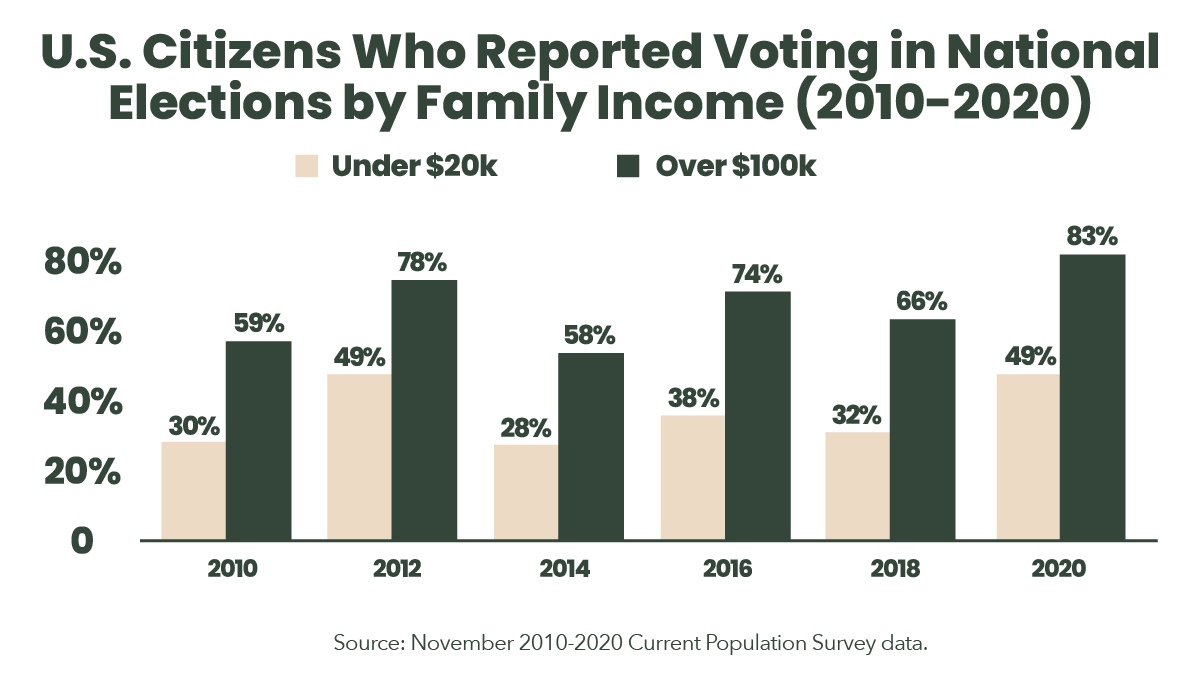13-2 Housing Is Built With Ballots: History of the Voting Justice Movement and the Fight against Voter Suppression
Aug 17, 2022
The history of voting rights in the United States is littered with instances of systemic discrimination in which specific groups of people have been denied the right to vote based on their race, gender, religion, and other characteristics. Originally, the right to vote was limited to white, Protestant, land-owning men. Eventually, states were allowed to determine who could and could not vote in their jurisdictions. While some states, like New Jersey, expanded voting rights beyond property-owning white men temporarily, many states continued to uphold the federal standard barring Black people, women, Native Americans, and immigrants from the polls.
In 1870 – nearly 100 years after the United States was established as a nation – the 15th Amendment was ratified. The amendment stated that citizens could not be denied the right to vote based on their race, color, or previous condition of servitude and meant that Black men were now able to vote and hold political office. However, after two Black men became members of the U.S. Senate in 1870, states – especially in the South – began to find new ways to disenfranchise people. Literacy tests, poll taxes, and “grandfather clauses” denying people the right to vote if their ancestors had not voted prior to 1867 made it impossible for descendants of enslaved people to vote. These voter suppression and intimidation tactics reinforced white supremacy and prevented people of color from being able to fully exercise their civic duties.

Fifty years later, the 19th Amendment gave women the right to vote. However, non-white women – including the descendants of slaves, immigrants, and Native Americans – still faced barriers that required them to continue fighting for their rights as citizens. Even after the 24th Amendment, which outlawed poll taxes, was ratified in 1962, people of color in the South still faced tremendous obstacles to voting. These obstacles motivated the struggle for civil rights that commenced in the late ‘50s and early ‘60s. One of the most widely known events in the fight for civil rights was the march from Selma to Montgomery, Alabama, in 1965. The march was led by activists Martin Luther King, Jr., Hosea Williams, and John Lewis, who were joined by hundreds of non-violent protestors. Even so, the marchers faced brutal violence. They were sprayed with tear gas and beaten by state police under the authority of Alabama Governor George Wallace, who demanded the march be stopped by any measures necessary. Because the march was televised, it drew national attention, and Americans across the country were able to witness what became known as “Bloody Sunday.” This crucial moment persuaded President Lyndon B. Johnson to sign the “Voting Rights Act” into law later that year. The act outlawed common voter suppression tactics, such as literacy tests, created federal oversight in states and localities with a history of voter discrimination, and extended federal voting protections to Black women, Native Americans, and immigrants. While the law was a major step forward for civil rights, its passage was far from marking the end of voter suppression.
Since the passage of the Voting Rights Act in 1965, other protections have been passed to ensure all citizens can exercise their right to vote. These protections include the 26th Amendment, ratified in 1971, which changed the voting age from 21 to 18 in response to the draft that was instated during the Vietnam War. The Voting Rights Act was expanded in 1975 to cover those who spoke different languages, and two decades later, Congress passed the “National Voter Registration Act of 1993,” allowing people to register to vote while applying for a driver’s license, through the mail, and at designated offices.
Despite these efforts, voter suppression persists. In Shelby County v. Holder, the United States Supreme Court effectively undermined the Voting Rights Act by ruling unconstitutional the provision requiring federal oversight of jurisdictions with histories of voter discrimination. Since that ruling, delivered in 2013, voter suppression efforts, including strict photo identification laws and limitations to mail-in voting, have only increased.
In 2021 alone, 18 states enacted 34 new laws that restricted access to voting – the greatest number of restrictions enacted in any year in the past decade. In 2022, legislators are continuing to attempt to restrict voter access. Over half of these new laws aim to restrict mail-in voting in response to the 2020 election, for example by adding barriers to applying for mail ballots and limitations on who can vote by mail. (You can read more about these voting restrictions in the next article.)
While the fight for voting rights has been long and at some points violent, the United States still has a long way to go to ensure all Americans are able to exercise their civil right to vote, free of suppression and intimidation. Organizers and advocates across the country are working together on the local, state, and national levels to ensure historically oppressed and disenfranchised groups know their rights, can register to vote, and can make it to the polls.